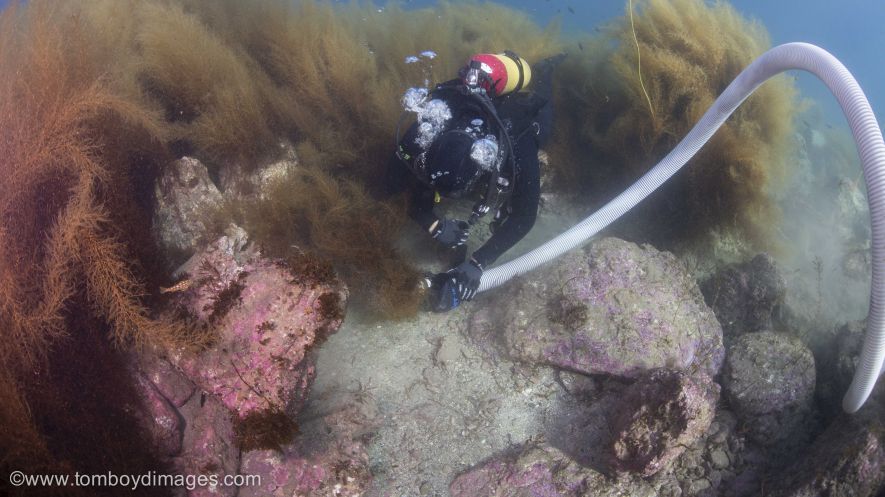A NOAA Fisheries pilot project to test targeted control of a highly invasive brown alga off southern California’s Catalina Island using a giant underwater vacuum tube known as the “Super Sucker” is yielding promising results, say scientists leading the project.
Last year research divers tested the efficacy of the Super Sucker in removing dense mats of the alga Sargassum horneri in several plots off Catalina Island. The method knocked down the Sargassum enough that when divers returned this year they found fewer plants growing in the test plots than in untreated control plots, said Adam Obaza of the West Coast Region’s Protected Resources Division in Long Beach.
The recruitment of Sargassum in the treated plots was about 30 to 40 percent lower than in the control plots, although a full analysis is forthcoming, said Lindsay Marks, a graduate student at UC Santa Barbara who has helped lead the research for her Ph.D. dissertation.
The fast-growing Sargassum introduced from Asia has spread widely in Southern California’s Channel Islands and some sections of the mainland coast, leaving little hope of eliminating it entirely. The Super Sucker, modeled after an effort originally developed in the Pacific Islands, may provide a useful tool for controlling its spread in certain places, such as sensitive marine protected areas or locations particularly important to rocky reef species, such as endangered white abalone that NOAA Fisheries recently included in its Species in the Spotlight initiative because it is at high risk of extinction.
“What we’re really hoping is this will provide some options to control the spread, and that we’ll see some additional interest from other organizations willing to help,” Obaza said.
Already Los Angeles Waterkeeper, which has long assisted with the restoration of California kelp forests, has shown an interest in recruiting divers to help with the fight against Sargassum. The Super Sucker may also provide an option for rapidly responding to outbreaks of other non-native species before they can spread widely, Obaza said. Prevention is by far the most effective method for controlling the spread of invasive species.
A diaphragm pump aboard a small boat at the surface powers the super sucker, drawing water up through a long hose. Divers feed the invasive algae into the hose for transport to the surface. The vacuumed material pours out onto a sorting table on the boat where crew can examine it for any bycatch of fish or other native marine life that can be returned to the water. Preliminary results show low levels of bycatch, most of which is returned to the ocean unharmed.
The device makes it easier for divers to remove larger amounts of Sargassum than they otherwise could, said Bryant Chesney, a senior marine habitat specialist for NOAA Fisheries’ West Coast Region who first heard about the use of the Super Sucker in Hawaii and proposed to test it on Sargassum in waters off California.
In winter 2015, teams extracted about 9,000 pounds of the alga from nearly one square kilometer off Catalina Island using the Super Sucker and hand removal, Obaza said. Some of those assisting with the removal have also tried making beer and soap with Sargassum in hopes of increasing awareness and potentially finding a commercial appetite for it.
Sargassum was first detected in Long Beach Harbor in 2003, and has since spread along the coast as far north as Santa Barbara and as far south as Baja California, as well as around offshore islands.
“The fact that it has expanded so quickly has some people getting more worried about how far it will spread, and how fast,” Chesney said.
Marks said she hopes the promising results of the Super Sucker trial will help create enough interest to lead to more strategic control efforts aimed at deterring further spread.
“If communities are willing to support consistent effort, the potential is there to make a difference at a local scale,” Marks said. Los Angeles Waterkeeper has launched an effort to track the spread of Sargassum and is seeking volunteer divers interested in participating.
Watch a video of divers testing the Super Sucker
LEARN MORE about S. horneri invasion and track its spread



